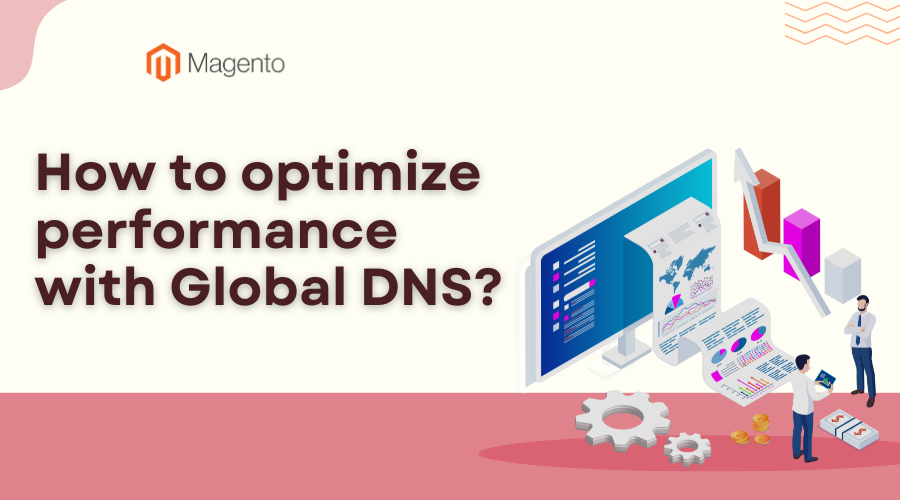
Magento 2 is one of the most popular open-source e-commerce website builders available today. It has also forayed into the world of PWA, or Progressive Web App. In layman’s terms, a PWA is a website that is installed on your computer; in other words, it is a hybrid of an application and a website.
PWAs are different from standard websites in that they can work offline, too. They are made using web technologies like HTML, CSS, Javascript, etc. They are also cross-platform, just like websites, but they behave like apps.
Their greatest advantage is their performance. They load way faster than any website, even on slow connections, and they are highly optimized for mobile phones. In this article, we will check out how Magento 2 PWAs can be optimized for better performance using a Global DNS (Domain Name System) strategy.
Table of Contents
I. Why is Performance Optimization Necessary?
The success of a business depends on its service. Online businesses don’t provide a service in the traditional way. Their service is tied to their online platform, or rather the user experience it provides. This means that the easier the website/app is to use, the better the customer service.
The performance of a website directly contributes to its ease of use and reliability. A fast, responsive website that seamlessly loads anything requested of it is much easier to use than a slow, laggy website.
In fact, research has shown that the website conversion rate rises by 17% for every second cut from the loading time. Since a PWA is functionally a website, and Magento 2 is an e-commerce platform builder, the performance of its PWA needs to be really high for it to be successful.
1.1. How Does DNS Affect the Performance of a PWA?
Since a PWA is made using web technologies, it means that it loads pages and resources from a server. This means it needs to communicate over the internet and locate the server using its IP address.
Whenever IP addresses are involved, DNS is involved as well. A DNS is the entity that helps a client (any computer or device making a request) resolve the domain name to the IP address.
Computers do not know the location of the server on the internet. They only know the domain name of a website. They send this domain name to a DNS resolver (a server provided by the ISP) and ask it to send its IP address. The DNS resolver then queries the domain name servers responsible for the requested domain. They return the IP address of the server containing that domain.

The resolver then sends this to the client, and this is how the client knows which server to go to to fetch resources.
A PWA uses the computer it is installed on to generate requests for the server from which it needs to fetch resources. The longer the DNS resolution process takes, the slower the PWA will work. It will fail to load webpages in time, which will result in a slow and laggy experience for the user.
Research has shown that 75% of visitors abandon websites that take longer than 4 seconds. This means that 75% of the conversions could be gone just like that. Since PWAs are designed for fast loading, the only bottleneck that remains is the DNS system. If it lags, then it may compromise the e-commerce PWA.
II. How to Optimize Performance Using Global DNS Strategy?
Since the importance of DNS in the function of PWAs has been understood, let us take a look at how you can optimize the performance using a DNS strategy.
2.1. Select a Reputable Global DNS Provider
The domain name system is not a centralized system. Different organizations own different parts of it. They provide their services using the parts they own and renting the parts they don’t own. So, the first thing you should do when developing your PWA is to use a reputable and reliable DNS service provider.
Companies like Cloudflare, Quad9, and Google are big players in the DNS sector. They have optimized their systems to deal with any kind of DNS request as quickly as possible.
PWAs are an evolution of websites, so it is possible to use them to track user data. Use the data from them to learn which geographical region makes up the brunt of your customers. Then, use a DNS provider whose network reach caters to that region.
Here are some other properties of a good DNS provider.
- Good management tools. A good DNS provider also has great management tools that let you create and manage your DNS records. DNS records are critical for the domain name system’s functioning.
- Latency and Uptime. A good DNS provider is one whose network is reliable and has little to no downtime. Their network must also have very little latency so that requests are resolved quickly.
- Security. DNS systems are susceptible to various security flaws. To keep your data and users safe, you should use a provider that implements security measures like DNSSEC.
These are just some of the things that you should look out for when looking for a DNS provider.
2.2. Configuring DNS Records
Securing a good DNS provider does not automatically make your PWA faster. If you are not configuring your DNS records properly, then you are still leaving performance on the table.
The most important records are the A, AAAA, and CNAME records. You need to set these records up in your DNS provider’s management tools for the most efficient DNS resolution.
Let’s take a quick look at what these records do and how they help with improving PWA performance.
A records are used to resolve requests for domains with IPv4 addresses. AAAA records are for IPv6 addresses. You should have multiple A and AAAA records for a domain. The extra records should point to other servers where you have stored your domain information. This helps with load balancing because multiple servers can handle the requests. But more on that later.

CNAME records can alias one domain name to another. Its most obvious advantage is that complex domain names can be aliased to simple and memorable names. This means that your PWA user does not have to memorize any complex domain names. This improves their user experience.
2.3. Deploying Load Balancing Techniques
Load balancing is the art of managing that traffic without overwhelming the DNS system. It is by far the most important aspect of speeding up DNS resolution and, by extension, increasing the PWA performance. E-commerce PWAs incur massive traffic during the holidays and when they are holding sales.
Anytime big deals and discounts are happening, you can guarantee that many people will flock to the store to pick something up. This increase in traffic can result in congestion and slowdowns.
With load-balancing techniques, it is possible to combat these slowdowns and reduce them effectively.
DNS records are quite effective at load balancing. Here are some common examples.
- Multiple A/AAAA records that point to different nameservers provide redundancy. In case one nameserver is getting encumbered, the other nameservers can start entertaining requests to share the load.
- Cname records are used to alias subdomains to other domains. In a situation where you want the PWA’s access point to be configured differently from the server configuration, a Cname record is really useful. It allows the PWA’s domain to be aliased to a different domain, which has its own server configuration.
By optimizing your global DNS settings for load balancing, you can ensure that your PWA never faces a slowdown or shutdown due to DNS congestion.
2.4. Regular Monitoring of DNS Records
Part of any strategy is to monitor your efforts to see if they are working as intended and adapt to changes on the fly.
This means that you need to check if your DNS records are configured correctly and monitor your PWA traffic. There are various tools and software that can help with both.
Since a PWA is essentially a website in its function, you can add trackers on it to learn when people are using it or not. You can also add trackers that check whether the PWA was opened by the user (via tapping on the icon) or it was opened by a web link.

Using the information from the trackers, you can measure traffic from the PWA and other interactions as well. This takes care of the client side, but what about the DNS side?
You can use tons of online tools for that. A tool for DNS record lookup can help you check and validate your A, AAAA, Cname, and various other types of records. With such tools, you can ensure that your load-balancing configuration is working as intended.
Conclusion
A global DNS strategy for PWA optimization is something that slips the minds of most people. After all, there are so many other ways to improve a PWA’s performance. However, this method is for dedicated people who want to achieve the best performance for their PWA. The best thing about it is that it is quite straightforward to implement.
Read more:
- 1. Crafting The Perfect Online Store In 2024: Website Development & Design Essentials
- 2. B2B eCommerce Websites: Best 10 Platforms In The USA For 2024
- 3. Develop A Website: Top 10 Things You Need To Think About












![[SALE OFF] Discount 30% All Premium Extensions On Christmas And New Year 2025 christmas-and-new-year-2025](https://landofcoder.b-cdn.net/wp-content/uploads/2024/12/christmas-and-new-year-2025-1-218x150.png)






